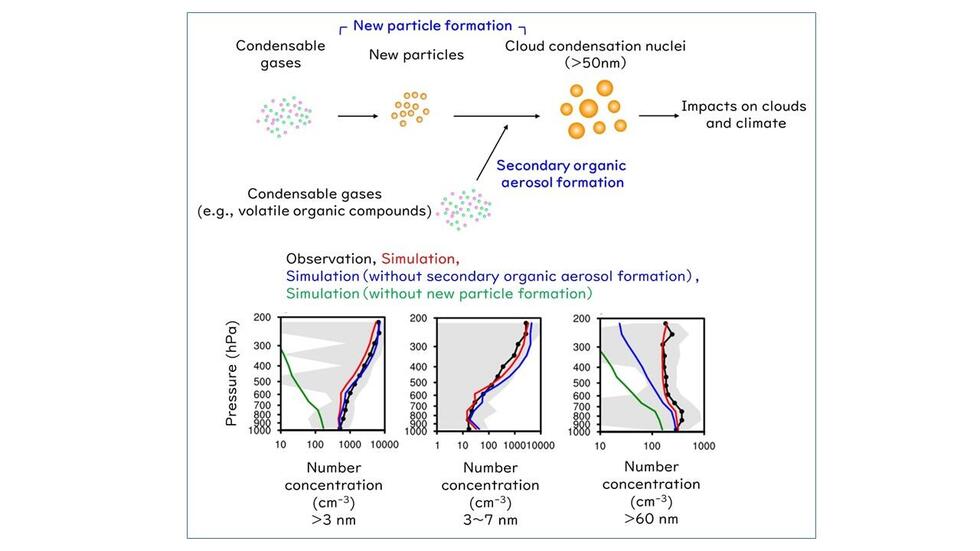
Complex systems
December 8, 2022
Organic aerosols in remote regions are forming clouds and have an underestimated effect on climate change
A research group from Nagoya University in Japan has developed a model to clarify the importance of analyzing the formation of clouds from human and natural particles. Since many climate models simplify the formation of atmospheric particles from organic vapors, these findings could lead to more accurate predictions of climate change and global warming.
Primary organics are gases or particles that are emitted mainly from fossil fuel combustion, industrial processes, and the burning of plants and trees. When these components enter the atmosphere, they interact with atmospheric oxygen and sunlight. This process converts them into secondary organic aerosols, a major constituent of PM2.5 particulate matter that harms health and the climate.
A subset of these aerosols can even serve as cloud condensation nuclei, which, as their name implies, form the nucleus that clouds form around. Such changes in cloud properties affect their ability to reflect both short-wave and long-wave radiation, consequently influencing the Earth's radiative balance.
Associate Professor Hitoshi Matsui at the Graduate School of Environmental Studies, Nagoya University, argues for the importance of the distribution of these cloud condensation nuclei in remote areas, especially over the Pacific and Atlantic oceans. “As remote ocean areas cover a large fraction (about two-thirds) of the Earth’s surface, remote clouds play a critical role in determining the Earth's radiative balance,” he said. “Understanding the driving factors of cloud condensation nuclei in remote areas is therefore helpful in creating reliable climate projections.”
Together with Liu Mingxu, also at Nagoya University, Matsui combined an aerosol-climate model with aircraft measurements to assess the magnitude of secondary organic aerosol formation and growth. Their study revealed that the formation and growth process of atmospheric fine particles, something not considered in many climate models, influences the number of cloud condensation nuclei in remote areas. Their findings appeared in Geophysical Research Letters.
The researchers found the formation of cloud condensation nuclei from secondary organic aerosols affects clouds. “Cloud condensation nuclei formed from secondary organic aerosols enhance the ability of clouds to reflect sunlight back to space,” explains Matsui. “This means that secondary organic aerosols have the potential to increase the magnitude of the cooling effect by clouds on the climate.”
To investigate the effect of cloud formation from secondary organic aerosols on cloud radiative forcing, the research group also looked at trends from preindustrial times to the present day. Cloud-radiative forcing refers to the effect of clouds on the amount of radiation emitted to space or absorbed by the Earth and the atmosphere. They found that the fractional contribution of secondary organic aerosols to cloud condensation nuclei was greater in preindustrial times than in the present, and the cooling effect of clouds by secondary organic aerosols was also greater in preindustrial times than in the present day.
“Our study revealed that atmospheric secondary particle formation is one of the main processes that determines the number of cloud condensation nuclei in remote areas,” explains Matsui. “The most important implication of our research is to guide climate models to improve the accuracy in modeling cloud radiative forcing and to better predict future climate change. The effect of atmospheric particles acting as cloud condensation nuclei to change cloud properties is uncertain in the prediction of climate change. We expect this to be an important finding that will lead to a more accurate prediction of future climate change and global warming.”
The study, "Secondary Organic Aerosol Formation Regulates Cloud Condensation Nuclei in the Global Remote Troposphere," was published online in the journal Geophysical Research Letters on September 7, 2022, at https://doi.org/10.1029/2022GL100543.
Authors:
Mingxu Liu and Hitoshi Matsui
Media Contact:
Matthew Coslett
International Communications Office, Nagoya University
kouho-en@adm.nagoya-u.ac.jp